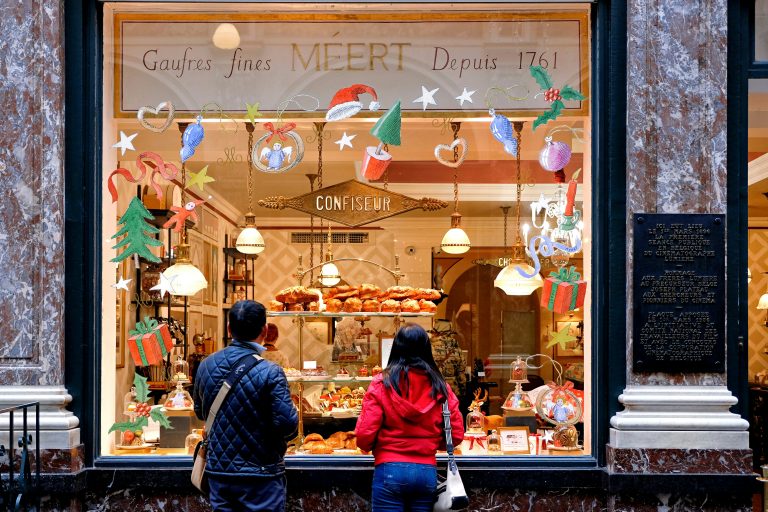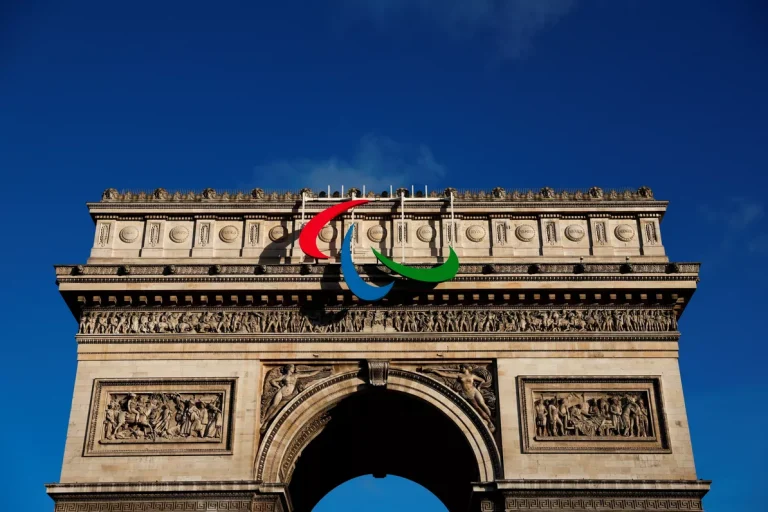For our second itinerary of the year, we’ll go back in time à la Marty McFly! So, we set course for the late 19th/early 20th century in France’s main industrial region, buzzing with laundries, dyeing factories, aviation manufacturers, car makers, radio components producers and more – the list goes on and on! Come with us to Puteaux and Suresnes to see what remains of these workshops, which were often scaled up to factory size, and which are still remembered as successful ventures to this day.

Starting point: Station n°21501 Pont de Suresnes
Finishing point: Station n°28001 Richard Wallace – Place du 8 mai 1945
Journey time: more or less 2h
After you’ve picked up your Vélib’, turn left down Allée de Longchamp then right onto Quai Léon Blum.
Suresnes, Perfume City
-
Quai Léon Blum
Stop on the Quai Léon Blum in front of a red brick building. We’ll start our trip with François Coty’s old factory, hidden away in the Bel head office, famous world-wide for its cheeses. Before it became the temple of Babybel and the Laughing Cow, a very different kind of smell emanated from the factory – the ‘juice’ (fragrance) itself, bottles and packaging. The building also housed the head office and the research, design, marketing and sales departments. Now that’s what you call a vertically integrated company!
©South view of Bel ‘s Head office (old Coty factory) Suresnes, by Celette, Wikipédia.
At Suresnes, François Coty used the latest chemical products in the shape of synthetic fragrances. They would enable him to create a luxury perfume without the luxury price tag – a pioneering development at the time. The bottles are exquisitely elegant, having been designed by Baccarat and then Lalique. They were mass-produced, with the crystal stoppers being hand-carved.
Coty’s very first perfume, which came out in 1904, was a roaring success. Called ‘Rose Jacqueminot’, it paid tribute to the pharmacist from whom Coty first discovered eau de Cologne before moving to Grasse. The factory expanded rapidly, growing from 15,000m² in 1915 to the point where it was the town’s biggest employer. The 4,000 employees received a number of benefits that were really ahead of their time: a pension fund, a savings fund, paid holidays etc. Architect Jean Barot oversaw the expansion of the site in 1936 when the soap factory, the powder and cosmetics factory, the administration and HR departments, warehouses and plant rooms all needed somewhere to go!

©Lithography « The dance of perfumes », by Sem (Georges Goursat),for Coty, wikicommons
François Coty was certainly extremely ambitious! In 1907, he bought the northern part of the château de la Source estate at 11/13 boulevard Sellier. We don’t know whether it was coincidence, but this was where Marie-Antoinette’s perfumer used to live…
-
Rue de Saint-Cloud, where Fargeon, the Queen’s master-perfumer once worked
Go back up Allée de Longchamp and then turn left down the Rue de Saint-Cloud.
At the end of the 18th century, Fargeon set up shop in a farm building located right on this very street. Here he created his perfumes, even using Damask roses, grown on the slopes of the local hill known as Mont Valérien. However, he abandoned his workshop very soon after the French Revolution. It wasn’t sensible to be advertising your status as perfumer to the Queen at the time…
-
The parc du Château
Go down Rue des Meuniers until you reach the entrance to the parc du Château. Park your bicycle, go through the entrance on foot and go down the first steps. Stop a little before the fountain and you’ll see a bas-relief…

©Coty factory, Suresnes, 1927, Gallica, Wikicommons
The main entrance to the Coty factory featured two water features, each of which were decorated with a bas-relief. Women had pride of place here, kneeling in front of an incense-burner (what else?!). These young women were designed by the tireless – and world-famous – creator of perfume bottles we mentioned a little earlier: René Lalique. He worked with many perfume-makers, all of whom took their inspiration from the very successful approach adopted by Coty method (creating striking, novel bottles and packaging) and all lived in Suresnes for at least a while. When you think about it, Coty was a bit like the Steve Jobs of his time…
To name but a few of these perfumers, we have René Duval, the former head of sales at Coty (now there’s a surprise!), who founded Parfums Volnay with his wife Germaine Madeline. Most of this firm’s bottles were designed by René Lalique. Up until as late as 1987, the Volnay factory was located near Mont Valérien on Boulevard Henri Sellier.
Moving on, there was Richard Hudnut. Originally a pharmacist, this US citizen relocated to rue Pagès, Suresnes in 1920 and exported cosmetics and perfumes to the United States, giving his products winningly ‘chic’ French names such as ‘Fleurs à vous’ and ‘La Rêverie’. With the 1950s came massive increases in the company’s energy bills: the factory moved lock, stock and barrel to the other side of the Atlantic in an example of early ‘eco-responsible’ corporate thinking…not!
Last but not least: Maurice Blanchet is the final ‘nose’ on our itinerary. A real forward-thinker, he took over the Salomé brand, founded by Hugues Guerlain (it seems a bit of a twist of fate that this man should share his surname with the famous Paris-based perfumer) and merged it with his own company, Coryse, creating Coryse Salomé. The company’s factories were located on the site of the former vegetable garden of the Château de la Source!
To infinity and beyond (thanks to the aviation industry), at the Blériot Aéronautique factory (now EADS)
-
5 quai Marcel Dassault à Suresnes

©Google, Screenshot, Grand Paris Skema’s campus with the mosaics of the old Blériot factory.
Get back on your Vélib’ and ride alongside the park before going down Rue Pasteur, then taking a left onto Rue Marcel Monge and then a right onto Quai Marcel Dassault.
Vélib’ top tip: dismount and walk along the pavement so you can admire what remains of the old factory’s façade.
Let’s start with a little historical background. Aviation, like cycling and motor cars, developed thanks to those who competed in races and strove to beat records… On 25th July 1909, Louis Blériot crossed the English Channel in his Blériot XI, a light single wing aircraft, in 37 minutes, which was a world-first! Trading as Blériot Aéronautique, he threw himself into the business of making airplanes, building more than one thousand at Courbevoie. The manufacturing venture was so successful that the French Army became a client, obliging him to move to Suresnes and expand his operations. By 1915, the factory covered a total of 28,000m². 2,500 people were employed there, with work going on night and day! Over the course of the four years of WW1, 10% of all airplanes constructed in France were built at the Blériot site.

©A Blériot XI airplane, unknown author, Wikipédia.
After 1918, Louis Blériot tried to branch out, diversifying into hovercraft, motorcycles and sand yachts, none of which unfortunately were the success he had hoped for. It’s a good reminder that generally speaking, war is often bigger business than sport. In 1921, Blériot Aéronautique merged with the Société pour l’aviation et ses dérivés, the new company being called Blériot-SPAD.
On 11th August 1936, ten days after Louis Blériot’s death, a new law was passed, nationalizing businesses involved in the production of armaments. Blériot-SPAD changed name but the company’s heritage was so deeply rooted in the collective psyche that many workers continued to say ‘I work at Blériot!’. Multiple mergers and name changes later, the company became EADS in 2000 (European Aeronautic Defence and Space Company). However, you’re probably more familiar with its most recent name, adopted in 2014 – that of Airbus.
Let’s leave the world of aviation behind and turn to haute couture
Go up the first street on your right, the Rue du Val d’Or, then keep going until you see Rue Henri Regnault on your right, follow this street until you see Rue Fernand Forest on your right, named after one of the inventors of the internal combustion engine!
Vélib’ top tip: pay particular attention when crossing Boulevard Sellier.
-
Pavillon Balsan, rue Worth

©Hôpital Foch, Pavillon Balsan, by Celette, Wikicommons.
To get to our next stop on Rue Worth, look at the map at the start of this article to find your way there. And no, you’re not dreaming, you’re still in Suresnes, not in Normandy. The pavillon Balsan, located inside the Hôpital Foch complex, was built in 1892 by the elder son of Charles Frederick Worth, a talented fashion designer of whom we shall speak at greater length shortly. Drawing inspiration from the ‘bathing resort’ chic so popular with the upper-middle classes of the time, the building is named after the ex-duchess of Marlborough, cousin by marriage to Winston Churchill, who later rejoiced in the name of Consuelo Balsan…
It was in this house in 1924 that Jean-Philippe Worth brought the worlds of haute couture and perfume together. He founded Parfums Worth with Maurice Blanchet and René Lalique (two people that we came across earlier in own journey!).
-
Hôpital Foch, 15 avenue Franklin Roosevelt
Vélib’ top tip: be careful as you go down the avenue – make sure you wait for the traffic lights. Don’t stop on the road itself – go onto the pavement so you can admire the building in peace – making sure you’re leaving pedestrians enough space to get past you.
Take a look at the two snails on the entrance doorway of this house, which, at one time was as big as the entire hospital! The inventor of the fashion show, Charles Frederick Worth was the big name in the fashion world at the time of Napoleon III, even becoming the official dressmaker of the Empress Eugénie. In 1854, he had a château built for himself at Suresnes. The extravagant parties attended by everybody who was anybody in Paris were described by the writers, the Goncourt brothers. To his English-style garden (which already boasted follies, waterfalls and hothouses with exotic plants), he added sculptures from the garden of the Tuileries palace, after the latter was burnt down by the Communards in 1870. Every little touch helps…
Vélib’ top tip: at the crossroads lower down on the right, feel free to cross over on foot at the pedestrian crossing if you feel safer that way.
-
33 quai Gallieni, Darracq & Cie
Go straight down the Rue du Mont-Valérien, continue along Rue du Bac before turning left onto Quai Gallieni.

©Circuit de la Sarthe, René Hanriot with a Darracq car, Wikipédia.
In 1900, France was the number one car manufacturing country in the world: 30,000 cars were made here every year. The United States were second-placed, some way behind with just 11,000 cars made annually. Suresnes was where Alexandre Darracq, a manufacturer of bicycles, then cars, had his factory.
The name Darracq may not mean much to you (even though it was the third-biggest French make of car at the time!), but we’re pretty sure that’s not the case with Chevrolet! Everything began in 1899, when Louis Chevrolet was working as a foreman in Darracq’s factory. (This was before he became a racing car driver. He even earned himself the nickname of ‘the daredevil’). In 1911, he launched a new make of car with William Crapo Durant, the co-founder of General Motors. The new make was called Chevrolet. Soon after, however, a dispute triggered a rupture with the businessman. The racing driver sold Durant the rights to the name Chevrolet and his shares for one hundred thousand dollars. Given the brand’s success we might ask ourselves if Chevrolet very much got the worst of the deal.
-
Intersection of Rue du Ratrait and Rue Rouget de l’Isle
Keep along Quai Gallieni then turn left up Avenue George Pompidou, keep going straight and you’ll come to Rue du Ratrait. Take a good look at the point where this street and Rue Rouget de l’Isle on your right meet…
From 1895 on, Léon Levavasseur lived at the intersection of these two streets with his six children. We’ll head on to the next stop to tell you more about the story of this engineering genius!
-
1 rue Curie, Levavasseur’s workshops
Go up Rue Rouget de l’Isle, then take a right onto Rue des Bas Rogers before stopping at 1 rue Curie on your right.
.

©Flight simulator, Le Tonneau d’Antoinette, Levavasseur’s workshops, 1910, Wikipédia.
In 1903, the inventor designed the Antoinette 8V engine, named after the daughter of his financial backer, Jules Gastambide. It was an absolute game-changer for the aviation industry as it was light and struck the right balance between power and weight, making it excellent for racing boats and later, racing airplanes. The workshops in rue Curie, turned out one engine a week and very soon, the other manufacturers (Blériot, Farman, Latham…) adopted the Antoinette engine from Suresnes. In 1910, it was the most widely-used engine in the world!
Léon Levavasseur initially studied Fine Arts. This resulted in him designing airplanes which were both efficient and elegant. For example, the very bird-like Antoinette IV really stood out from most contemporary designs.
Marcel Bloch and Henry Potez moved into the same factory in 1917. (Marcel Bloch, a famous French industrialist and engineer, later changed his name to Marcel Dassault and is best-known under this name). Both men were engineers working for the Ministry of War. They started up the SEA, the société d’études aéronautiques, an aircraft manufacturing company. They produced the SEA IV two-seater fighter plane that was designed to help France win the war. However, fate had other ideas. The first production model left the factory on November 11th 1918 – Armistice Day. Of the initial order for 1,000 planes, only 115 were actually built.
-
A trip down motor car memory lane, from Rue des Pavillons to the Quai de Dion-Bouton
Go back the way you came and head along Rue Paul Bert, which is directly opposite Rue Rouget de l’Isle. Take a right turn down Rue du Bicentenaire, then a left onto Rue Eugène Eichenberger before turning right again down Passage Jean Nennig. At the end of this street you’ll see another very narrow street ahead of you, Rue Mars et Roty, which will take you to Rue Henri Martin. Turn left down this street until you reach Rue Saulnier, where you should turn left, then immediately take a right onto Rue de l’appel du 18 juin before continuing onto Rue des Pavillons.

©De Dion-Bouton factory, La Rentrée des Ouvriers, Puteaux, postcard, Wikipédia.
Nothing of the original Dion Bouton factory remains, but the distance you’ll have travelled on bicycle between Rue des Pavillons and Quai de Dion-Bouton will give you an idea of its former size! Built in 1884, it was the first factory to design its own cars from start to finish, whilst simultaneously making engines for over 200 automobile makers including Delage, Peugeot and Renault. By 1900, de Dion was the largest automobile and engine manufacturer in the world! One reminder of this company may still be found in our cars’ glove compartments.
Before the firm filed for bankruptcy in 1927, it created a famous series of road maps, which would later be used by Michelin…
-
See the île de Puteaux from the Quai de Dion-Bouton
Go down the Quai de Dion-Bouton. Let’s finish this itinerary by coming back to our first love: François Coty! He moved his secondary workshops, devoted to packaging manufacturing, gilding or bottle carving to the île de Puteaux.
Vélib’ top tip: be careful when you cross the crossroads at the beginning of the Pont de Puteaux bridge. If you don’t feel happy about cycling across, just dismount and walk over the pedestrian crossing. Once you get over to the other side of the crossroads, you’ll find a cycle path on the pavement.
-
Atelier Gaston Garino, 18 rue Parmentier

©Ville de Puteaux
Would you like to find out more about the crazy world of cars? Cycle down the Quai de Dion-Bouton and take a right turn onto Rue Parmentier, where you can stop off at a small museum dedicated to motor vehicles, the atelier Gaston Garino. Here you can wander around a marvellous collection of five cars, two engines and, best of all, six bicycles made at the turn of the 20th century by the famous car manufacturer. After all, although this itinerary has given pride of place to the automobile, like you, our loyalty towards bicycles knows no bounds! You can leave your faithful steed at the Vélib’ station on Boulevard Richard Wallace.



